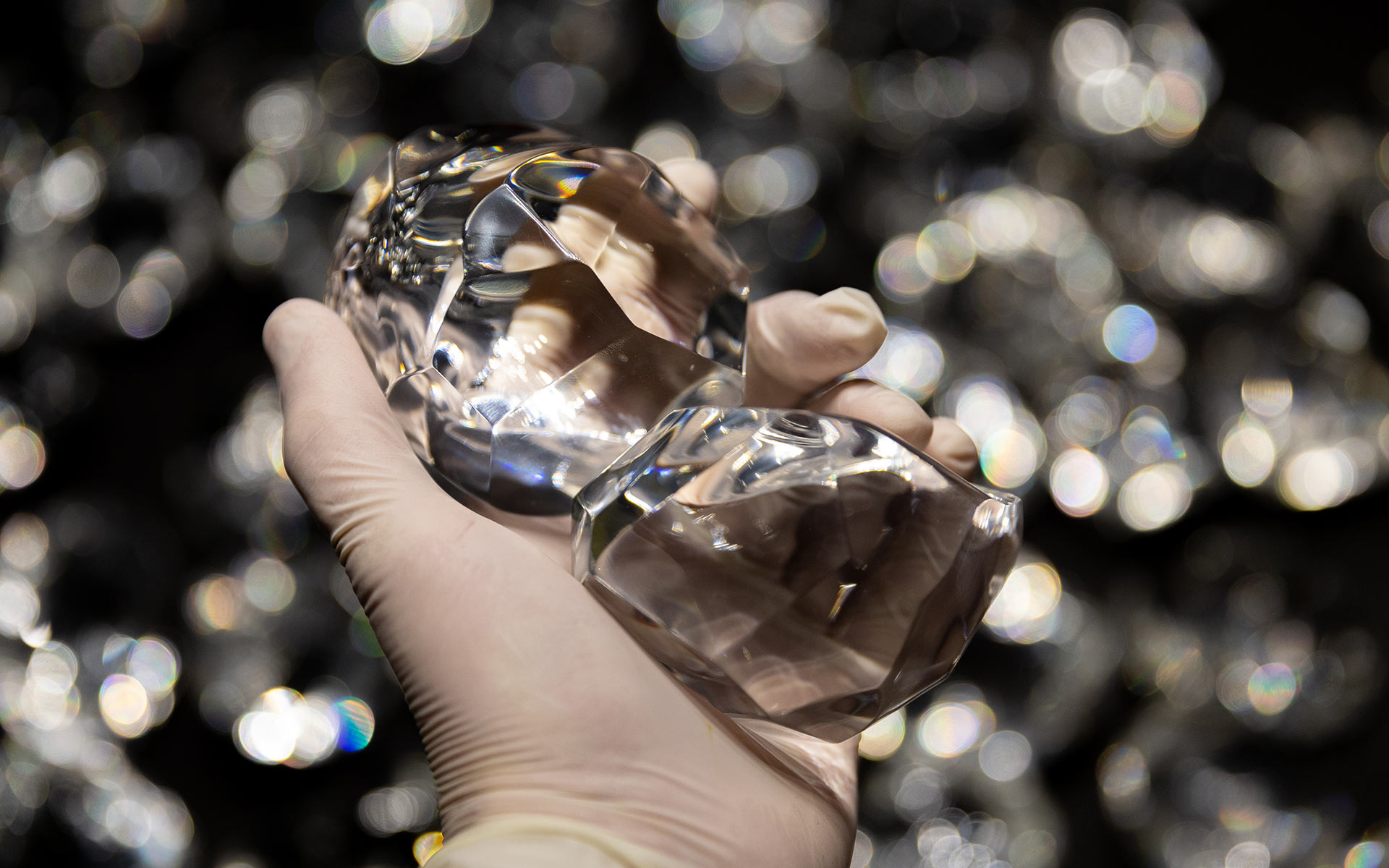Over the years a number of different plastics have been invented and this has left a phenomenal imprint on the manufacturing industry and created a revolution of useful possibilities – from functional objects through to the arts and sculptural design.
This wonderful material is used in the decorative arts world because of its versatility, which allows for an array of aesthetic details, patterns and light play. Whilst the widespread use of plastic in day-to-day life has come at a price, it remains a viable option for investment lighting pieces that will stand the test of time.
 Optically clear acrylic must have some form of surface detail or distortion to allow light to “bounce” around
Optically clear acrylic must have some form of surface detail or distortion to allow light to “bounce” around
Acrylic is a material we often use in our designs and there are numerous manufacturing processes that can be applied to this particular medium depending on its original state – from casting and thermoforming to CNC machining and laser cutting. When designing bespoke lighting products, the process of casting acrylic lends itself well to the aesthetics of a feature piece. For example, it allows for encapsulating matter, colour tinting, frosting and gradients; it can even be cast as a simple clear entity in itself and used for its optical clarity to bend and distort light.
 Droplet-shaped acrylic components with distinct finishes to create different lighting effects
Droplet-shaped acrylic components with distinct finishes to create different lighting effects
The process of casting acrylic can open up a world of intriguing experiments and originally began by hand moulding techniques that later developed using CAD technology. This allows us to create almost any shape achievable, which can lead to a range of artistic possibilities and experimentation with form and composition based on the client’s brief.
We start with modelling a design on CAD that is then 3D-printed to produce the “master” or primary object. This is then used to create a mould where the liquid acrylic is poured and solidifies during the curing stage.
 The making of an acrylic mould
The making of an acrylic mould
The beauty of being able to encapsulate objects in acrylic means that a personal touch can be added to a client’s lighting feature – using the likes of sentimental items or memorabilia. Other objects that can make a luminaire distinctive include textured woods, precision metal-etched patterns, gold leaf or even glass objects. With this approach, experimentation is key because imperfections or heat reactions can occur. But whilst these may cause anomalies, some end up as beautiful flaws that slowly unfold, becoming trapped in their developing state.
 Encapsulated gold leaf
Encapsulated gold leaf
Interestingly, cast acrylic is optically clearer than glass (and not to mention much lighter and, in most cases, more cost-effective). For that reason, illuminating cast acrylic in its purest form can have an exceptional impact within an interior space. However, there are some hindrances: to transform intangible light into a beautiful visual an “element” must be added to the optically clear form whether it be facets, frosting or incorporating another material in the encapsulation process. If not, the object cannot contain the light – it simply passes through. Internal reflections and refractions from faceted or textured surfaces can create fantastic “caustic” effects when light is projected onto or through the material.
 Illuminated clear “over-run” acrylic creating a caustic effect
Illuminated clear “over-run” acrylic creating a caustic effect
Acrylic has an exceptional relationship with light when used thoughtfully, and it’s important to apply this understanding to the interior setting and surrounding surfaces and textures. For example, the caustic effect can look stunning as a projection within a space, but it would need to be directed in an intentional way because the effect can visually distract from complex wallpaper or create an undesired pattern on a dining table. To prevent this, alternative lighting solutions, such as uplighting, can be used to change the direction of light and create soft flowing reflections exclusively on the ceiling.
 Inspired by the serenity of water, this bespoke chandelier we created comprises hand-turned acrylic components shaped like droplets
Inspired by the serenity of water, this bespoke chandelier we created comprises hand-turned acrylic components shaped like droplets
When incorporating acrylic into our designs, we’re always mindful of the waste produced and champion processes such as “over-run”, which involves using excess cast acrylic from other projects that are collated into one mould. Certain existing acrylic forms can also be melted and re-formed, or adapted and re-polished for a new lease of life with the “make do and mend” approach. Not only does acrylic permit us to explore sustainable ways of creating decorative lighting products, it’s also versatile and inexpensive, and it allows for an abundance of artistic finishes. It’s a wonderful material that should not be overlooked.
More in our Materials Matter series can be found here: Ceramics and Glassblowing